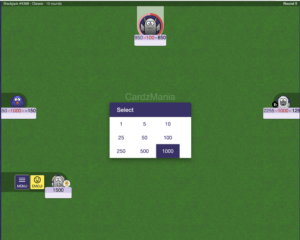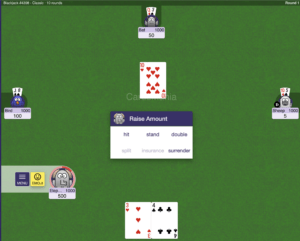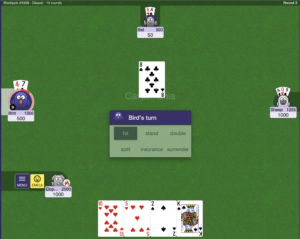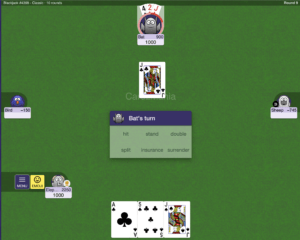Blackjack is a card game that requires strategic thinking and luck. According to the Crescent School of Game and Bartending, blackjack originated in French casinos in the 1700s. The game targets individuals that enjoy chance-based games. It is also an easy game to play, making it attractive for beginners. This design choice is advantageous as it allows new players to quickly grasp the rules and start playing, thus broadening the game’s appeal. For my critical play, I played Blackjack on the website CardzMania.
Blackjack puts players at risk for addiction by engaging them through elements of randomness and skill. The game’s use of random hands, draws, and the ability to observe other players’ cards and decisions makes it compelling. Additionally, the game’s engagement with probability through decision-making and risk assessment deepens player involvement. Compared to other games that use chance, blackjack’s combination of randomness and strategy provides a sense of control and achievement, reinforcing its addictive potential.
Blackjack consists of a compelling gameplay loop based on its three main mechanics that maintain player engagement. The first mechanic is the random hand that players are dealt. Immediately, players create a mental model based on their hand and the dealer’s (the computer’s) visible card; players begin to assess their chances of winning. Although the initial hand is random, the element of unpredictability is captivating. This creates a risk for addiction, since uncertainty of which cards players will receive can cause players to continue playing in hopes they will obtain a winning combination. This mechanic of the game is similar to other casino games where players often seek rewards despite the randomness involved.


The second mechanic is deciding how to create the hand combinations, in which players typically stand or hit. This mechanic is the second part of the gameplay loop where players decide how to proceed. In this decision-making stage, players consider the probabilities of drawing favorable cards versus busting. Players must evaluate the risks and rewards associated with each possible decision. If players choose to stand or draw a card, the randomness of the draw can feed into addiction by adding a layer of suspense and excitement. Players assess the probability of receiving a sufficient card, which creates anticipation and hope for reward. This mechanic is similar to the game of poker where players must make uninformed decisions based on the potential to improve their position in the game.

The third mechanic of blackjack on CardzMania is the ability to see other players’ cards and decisions. In combination with the second mechanic, this mechanic contributes to how players engage with probability. Based on other players’ cards and potential draws, players calculate their odds of drawing good cards. The risk for addiction associated with this mechanic comes from the social dimension of interacting with other players. Players may develop a sense of competition and community that makes the game more difficult to quit. I believe this mechanic was a good design choice because it helps differentiate blackjack from other casino and gambling games. Many related games are solitary experiences, so the social component of blackjack not only increases player engagement and strategic thinking but also contributes to the addictive nature in a less negatively connoted manner.

Once players have engaged in mechanics two and three, they have completed the next step of the gameplay loop, which is taking action. Their actions then directly influence the game state and are a portrayal of manipulating the game rules in order to achieve a favorable hand. Players receive immediate feedback after each action is taken, since the outcome of whether their hand is still desirable or not is quickly revealed. This allows players to adjust their mental model and strategies for future hands, and it promotes positive reinforcement despite potential loss. Although players are rewarded on an inconsistent basis, the unpredictability of winning creates a motivation to continue playing. Each game serves as new potential for a rewarding outcome, and the anticipation of a possible win can be more engaging than a series of losses.
Along with the social component of the game, blackjack differs from related games of luck by incorporating skill. The outcomes of blackjack are not based purely on chance, since players must make decisions about their hand combinations. This fulfills the psychological need for achievement, since players have a sense of autonomy and control over some of their decisions. Similarly, the psychological need for achievement and power is fulfilled when players win a hand, especially when they have to make strategic decisions that contributed to their success. This creates a sense of mastery over the dealer and other players and makes the game more addictive than a game of total randomness.
In short, blackjack successfully combines randomness, skill, and social interaction to create an addicting game that appeals to all players.



